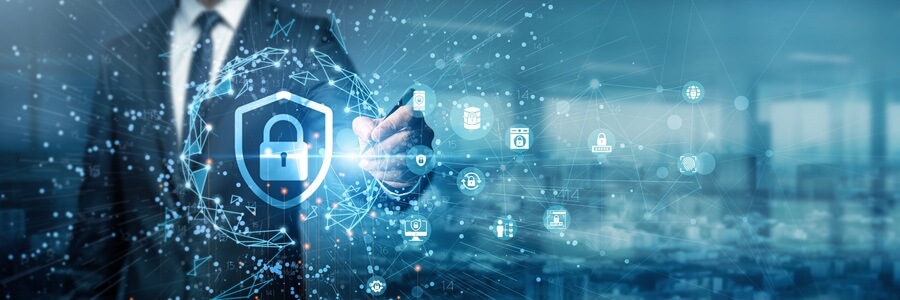6 Cybersecurity Threats Facing Small Businesses

Quick look: It’s alarming but true: small businesses are a major target for cybersecurity attacks. In fact, one-third of all ransomware breaches impact companies with fewer than 100 employees. We’ve rounded up six cybersecurity threats every business leader should keep on their radar, along with how external partners, like a professional employer organization (PEO), can help employers of all sizes stay protected from online risks.
Cybersecurity is one of the biggest challenges for today’s employers. As more business operations move online and companies store growing amounts of sensitive data, cyberattacks have become more common and complex.
And while large corporations often make the headlines, small businesses are just as likely to be targeted. In fact, during the first quarter of 2024, nearly one-third of ransomware breaches affected companies with fewer than 100 employees, and 43% hit organizations with 101 to 1,000 workers.
That’s why it’s so important for small business owners to refine their cybersecurity strategy. Staying informed about common threats and partnering with experts to strengthen your defenses can keep your business safe. Below are six of the top cybersecurity risks for small businesses and how a human resources (HR) outsourcing provider can support your security efforts.
1. Phishing and business email compromise (BEC)
Phishing continues to dominate the cyberthreat landscape. Attackers increasingly use convincing emails and text messages to trick employees into revealing credentials or transferring funds. The FBI’s 2024 Internet Crime Report identified BEC scams as one of the costliest types of cybercrime, resulting in $2.7 billion in reported losses.
Protection tips:
- Enforce multi-factor authentication (MFA) on all accounts
- Require secondary verification for financial or payroll changes
- Train employees regularly to identify suspicious emails or messages
2. Ransomware and data extortion
Ransomware, a type of malware that encrypts a user’s data until a ransom is paid, remains one of the most disrupting cyber threats for SMBs. According to the World Economic Forum’s Global Cybersecurity Outlook 2025, ransomware attacks are the most concerning risk for CEOs and Chief Information Security Officers (CISOs), and can result in significant downtime and data loss.
Protection tips:
- Keep secure, offline backups and test them regularly
- Use endpoint detection and response tools
- Limit administrative privileges and segment networks
- Proactively develop an incident response plan
3. Unpatched and vulnerable systems
Verizon’s 2024 Data Breach Investigations Report (DBIR) found that one of the most common ways attackers gain access is by exploiting known vulnerabilities, especially through outdated software and misconfigured web applications. And this trend is growing: the exploitation of network vulnerabilities grew 180% year-over-year.
Protection tips:
- Install critical patches promptly and maintain a regular update schedule
- Use a web application firewall
- Run consistent vulnerability scans to identify and fix weaknesses
4. Supply chain and third-party risks
Small businesses often rely on managed service providers (MSPs), cloud vendors, or SaaS tools, putting them at risk if one of those partners experiences a breach. According to Verizon’s report, supply chain attacks have increased 68% year-over-year, with cybercriminals exploiting trusted third-party access to spread malware or obtain data.
Protection tips:
- Evaluate vendors’ cybersecurity practices before signing contracts
- Limit data sharing and enforce least privilege access for integrations
- Require vendors to notify you promptly of any security incidents
5. Weak passwords and misconfigured systems
Many breaches result from stolen credentials, password reuse, or unsecured cloud storage. IBM’s 2024 Cost of a Data Breach Report shows that compromised credentials are one of the top root causes of breaches, with average breach costs reaching $4.6 million.
Protection tips:
- Require strong passwords and MFA on all accounts
- Use centralized identity management and password managers
- Scan cloud and server configurations frequently to prevent accidental exposure
6. AI-enhanced scams
Cybercriminals now use artificial intelligence (AI) to automate phishing, impersonate executives, and create artificial audio or video messages, and over half of businesses have experienced AI-related vulnerabilities. Additionally, attackers are leveraging AI to scale ransomware and social engineering schemes, making scams more believable than ever.
Protection tips:
- Verify high-value or urgent requests using multiple communication channels
- Educate staff on the signs of AI-generated fraud
- Use secure, authenticated communication tools for sensitive exchanges
How a PEO helps prevent cyber attacks on small businesses
Understanding today’s biggest cybersecurity threats is the first step; taking action is the next.
The best way for SMBs to prepare for cyber threats is to have a clear, proactive security plan. However, many of these businesses operate without a dedicated CIO or in-house IT team, leaving cybersecurity responsibilities to busy leaders who are already focused on growth, serving customers, and managing their teams.
Partnering with a trusted expert who can help develop cybersecurity strategies, provide employee training, and deliver ongoing protection can give SMBs valuable peace of mind.
In addition to managing HR, payroll, and compliance, a professional employer organization (PEO) can also help protect your company’s data. For instance, ExtensisHR’s Information Protection Plan, part of its comprehensive Employer Protection Plan, ensures your technology platform is monitored and updated with the latest enhancements to:
- Cybersecurity
- Data protection
- Incident response
- Operational risk management
- Business resilience
- Third-party management
- Security testing and analysis
Additionally, ExtensisHR offers cyber liability insurance, helping SMBs prepare for the unexpected. This coverage can help offset costs related to system restoration, digital asset recovery, cyber extortion, breach response, and even business interruption or regulatory expenses.
PEOs also play an important role in strengthening your first line of defense: your employees. Through the ExtensisHR Knowledge Cloud, organizations gain on-demand access to training on cybersecurity awareness, browser safety, and protecting sensitive information both at work and at home.
With new cybersecurity threats emerging every day, partnering with a PEO like ExtensisHR can help you safely and confidently run your business. Contact us today to learn more about how we can help protect your people and your network.



